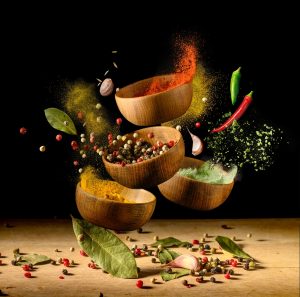Introduction: Egypt, a land steeped in history and culinary tradition, boasts a vibrant array of spices and herbs that have been essential ingredients in its cuisine for centuries. In this article, we’ll take a journey through the most common spices and herbs grown in Egypt, exploring their cultural significance, culinary applications, and the agricultural heritage that sustains their growth.

- Coriander (Coriandrum sativum): Fragrance of the Nile Dive into the world of coriander, a staple in Egyptian kitchens. Explore its cultivation in the fertile Nile Delta and its dual use of both leaves and seeds in traditional dishes like falafel, koshari, and various spice blends.
- Cumin (Cuminum cyminum): A Spice with Ancient Roots Uncover the ancient roots of cumin in Egyptian cuisine. Discuss its cultivation in the arid regions of Egypt and its role in dishes like kofta, stews, and the famous spice blend, dukkah.
- Mint (Mentha spp.): Refreshing the Palate Delve into the refreshing world of mint, a herb commonly found in Egyptian gardens. Explore its use in teas, salads, and the renowned mint-infused sauces served alongside grilled meats.
- Basil (Ocimum basilicum): Aromatic Elegance Highlight the aromatic elegance of basil, grown abundantly in Egyptian soil. Discuss its role in traditional dishes such as molokhia (jute leaf stew) and its use in salads, soups, and sauces.
- Parsley (Petroselinum crispum): Culinary Versatility Explore the culinary versatility of parsley, a herb that enhances the flavors of Egyptian dishes like tabbouleh, stuffed vegetables, and soups. Discuss its widespread cultivation and use in both fresh and dried forms.
- Dill (Anethum graveolens): An Herb of Distinction Shed light on the distinctive flavor of dill, often used in pickling and seasoning in Egyptian cuisine. Explore its role in dishes like fattoush salad, fish recipes, and its place in local culinary traditions.
- Fenugreek (Trigonella foenum-graecum): Nutritional Powerhouse Discuss the nutritional powerhouse of fenugreek, exploring its cultivation in Egypt and its incorporation into bread, spice blends, and traditional stews.
- Sesame Seeds (Sesamum indicum): Crunchy Goodness Spotlight on sesame seeds, a crunchy addition to Egyptian dishes. Explore their use in tahini, dukkah, and as toppings for bread, providing a delightful texture and nutty flavor.

2 Comments
I have read some excellent stuff here Definitely value bookmarking for revisiting I wonder how much effort you put to make the sort of excellent informative website
Thank you